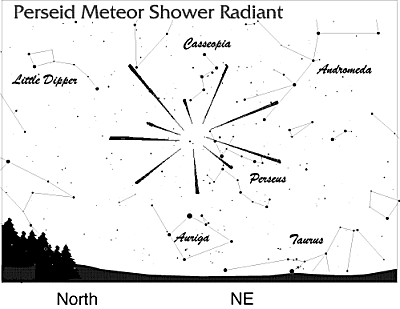Return to:
ICSTARS
1996 Perseids- The Sky Is
Falling!
by Tom Martinez
Astronomical Society of Kansas
City
What are the chances of you being struck by a meteor? The odds are very
slim. There are no records of anyone dying from a meteoric hit, and there
is only one case of someone being injured. On November 30, 1954, a meteor
crashed through the ceiling of Mrs. E. Hewlett Hodges in Sylacauga,
Alabama. The meteor bounced off a radio and struck her on the
leg.
Closer to the present, on October 9, 1992, a meteor crashed on the rear of
Michelle Knapp's car in Peekskill, New York. As the meteor came through
the atmosphere, breaking into fiery fragments, it was witnessed by hundreds
of observers along the eastern United States. There are newspaper accounts
of animals being killed, but no confirmed deaths of humans.
Even though 100 million meteors flash above our heads every day, we need
not worry because the majority of them are about the size of an apple seed
or smaller and burn up completely when they strike the upper atmosphere.
The majority of meteoric debris comes down as fine powder and adds several
million tons to the Earth each year.

If you have never seen a meteor flash across a star
studded night sky, now is one of the best times to catch a falling
star. As you read this, meteors from the most watched meteor
shower are now flying overhead. The Perseid meteor shower is
visible between July 25 and August 17, but like all meteor
showers, there is a peak period when you can see more than at any
other time. The night of August 11-12 is the best time to see
between 60 and 100 meteors per hour.
Most people confuse the difference between meteors and comets, but it is
easy to tell one from the other. A comet has head which is miles across
and a tail millions of miles long. They do not seem to move during a
single night, because they are actually out amongst the planets. Meteors,
on the other hand, are usually tiny grains traveling less than 50 miles
overhead, and disappear in seconds.
Surprisingly, meteors and comets are related. As a comet orbits around the
Sun, it leaves a debris trail along its path. Every year, the Earth
intersects the comet's orbit, charging through the dust at 66,000 miles per
hour. As we traverse through the comets path, the meteors appear to
radiate from a particular point in the sky. If you plotted each Perseid
you saw back to where it appeared, they would all point to a spot in the
constellation Perseus. Perseus rises in the northeast around midnight,
therefore you will see more meteors from midnight until
morning.
For a chance at seeing them at their best, pick a spot with few trees or
buildings to block your view. Give your eyes ten minutes to get dark
adapted by staying away from street and porch lights, better yet, go out
into the country, like Lewis-Young Park and Powell Observatory. Bring a
lounge chair to avoid neck strain, or lay on a blanket. Sweaters and
insect repellent will sometimes come in handy.
This is a good year for the Perseids, because the Moon will not hinder your
observations. To add to the beauty of this event, on the morning of August
10th, look for a beautiful crescent Moon just below brilliant Venus, and
Mars just to the left of the Moon creating a pretty
triangle.
An ancient German folk tale states that Saint Lawrence was tortured and
killed in Rome on August 10th, 258. The peasants believed that St.
Lawrence weeps tears of fire which fall from the sky every year at this
time. It may not have been a "Tear of St. Lawrence" that struck Mrs.
Knapp's car in 1992, and she surely is not shedding a tear for the crumpled
car. A collector paid $69,000 for the ten-year old Chevy and it's outer
space invader.
Zap me back to the ICSTARS Home Page.

